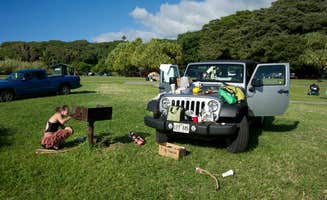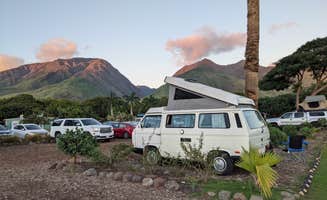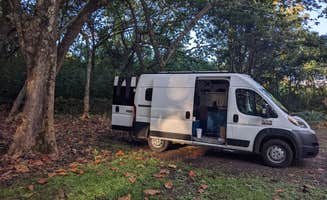RV camping near Lahaina, Hawaii provides access to both established campgrounds and natural wilderness settings. The western coast of Maui experiences average temperatures between 70-85°F throughout the year, with occasional wind gusts that can affect camping, particularly in exposed areas. Campers without advance reservations should prepare for limited availability during winter months when temperatures in mainland states drop and Hawaii becomes a popular destination.
What to do
Hike through bamboo forests: Visit Kīpahulu Campground within Haleakala National Park where you can access the Pipiwai Trail. "The most popular is the Waimoku falls that you reach by hiking through the bamboo forest up the Pipiwai trail. Camping at Kipahulu means that you can hit the trail early before the resort/day visitors make it to this side of the island," shares one camper.
Watch sunrise at higher elevations: Camp at Hosmer Grove Campground for easier access to Haleakala's summit without fighting early morning traffic. Located at 7,000 feet elevation, temperatures drop significantly at night. A camper notes, "Early risers will appreciate the short drive to the top of Haleakala for amazing sunrises... Sun sets are spectacular as well."
Kayak and paddleboard: Some campgrounds near Lahaina offer water equipment rentals at budget prices. "Can take relatively affordable kayaking tours from the campgrounds or rent SUP/kayaks for very affordable rates," reports one visitor who enjoyed these activities right from their campsite.
What campers like
Secluded beach access: At Waiʻanapanapa State Park Campground, campers can enjoy the black sand beach before day visitors arrive. "The park closes at sunset for all the other visitors, but campers can come and go and feel like you have the place all to yourself at sunrise just before the early permit holders arrive," explains one camper who appreciated the privacy.
Stargazing opportunities: The night sky visibility varies significantly between campgrounds. Near Kipahulu, campers report exceptional stargazing conditions. "At night, the stargazing is spectacular!" notes a reviewer who stayed in the area.
Hot showers: Several campers specifically mention shower quality as a deciding factor when choosing campgrounds. "The outdoor showers at Camp Olowalu resort are worth the stay in and of themselves. They are works of art, frankly," one camper states about the Camp Olowalu facilities.
What you should know
Permit requirements vary: Advanced reservations are mandatory for many campgrounds. At Waiʻanapanapa State Park, you need a timed entry permit for day use, but camping permits allow full-day access.
Weather fluctuations: Temperature variations can be extreme. At Hosmer Grove, temperatures can drop below freezing despite being in tropical Hawaii. "When people say it's cold up there, it's COLD... it got to about 30 degrees (probably dropped even more by midnight)."
Wildlife disruptions: Free-roaming roosters are common at many campgrounds and affect sleep quality. "Don't turn your back on the chickens. They'll get into your vehicle if given the chance," warns a visitor to Camp Olowalu.
Limited electrical access: Charging stations are minimal at most campgrounds. "Literally 8 plugs for a bajillion people causing a massive traffic jam in the mornings and evenings," notes one camper about the charging situation at a popular site.
Tips for camping with families
Consider wind exposure: Campgrounds without natural windbreaks can be challenging. At Camp Olowalu, "sooo many people evacuated to sleep in cars or resigned to/woke up to collapsed tents because of high winds," so secure your equipment properly.
Plan for sand management: Beach camping means sand gets everywhere. "The wood chips that line the pathways in the tent area are also pretty sharp, and my foot actually got cut on one even when I was wearing shoes - so be careful," warns a camper about Uka Hawaiian Native Camp.
Schedule around crowds: For popular attractions near campgrounds, timing matters. "If you hope to explore the gems of this district such as the Pipiwai trail, bamboo forest, and seven sacred pools - get up early and do them before the tons of tourists arrive for the day."
Tips from RVers
Size limitations: Most campgrounds have significant restrictions for larger vehicles. At Kipahulu Campground, "The campground itself is nothing to speak of- it looks mostly like a big green field with sites designated by grills and parked cars."
Water and supplies: Stock up before arriving at remote locations. For Haleakala area camping, "There's no running water, but two small buildings with pit toilets inside and hand sanitizer," and "Note that this campground is pretty far away from the closest town so you'll want to be sure you're all stocked up on fuel, water, and all the things you need."
Weekend vs. weekday experience: RV campers report significant differences in noise levels and campground atmosphere depending on day of week. At Pālāʻau State Park Campground on Molokai, the peaceful setting contrasts with busier mainland sites, making it ideal for those seeking quiet.




